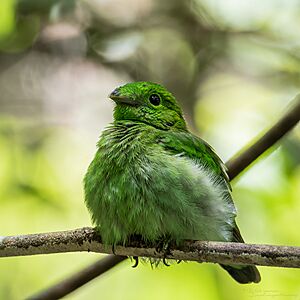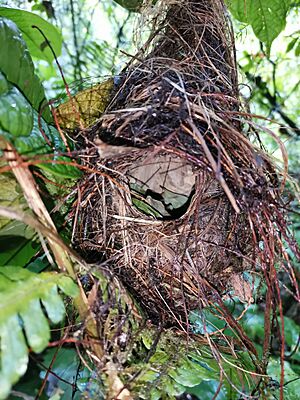Green broadbill facts for kids
The green broadbill (Calyptomena viridis), also called the lesser green broadbill, is a small, colorful bird. It belongs to the family Calyptomenidae. This family is known for birds called "broadbills."
Quick facts for kids Green broadbill |
|
|---|---|
 |
|
| Conservation status | |
| Scientific classification | |
| Genus: |
Calyptomena
|
| Species: |
viridis
|
 |
|
Contents
Where Green Broadbills Live
Green broadbills live in the warm, wet forests of Southeast Asia. You can find them in places like Borneo, Sumatra, and the Malay Peninsula. They prefer lowland rainforests and lower mountain forests. These birds love areas with lots of broad-leaved evergreen trees.
What Green Broadbills Look Like
This bird is about 17 centimeters (about 6.7 inches) long. It has bright green feathers, which help it blend in with the leaves. It also has a black patch near its ears. Its beak is wide and almost hidden by feathers on its head. The green broadbill has a rounded head and a short tail. Each wing has three black bars.
Both male and female green broadbills look similar. However, the female is a bit duller in color. She also does not have the black markings on her ear patch or wings.
Green Broadbill Behavior
Green broadbills are often hard to spot. They sit very still in the forest canopy, which is the top layer of trees. Their green feathers make them excellent at camouflage. If something disturbs them, they quickly fly to a new spot.
What They Eat
These birds mostly eat soft figs. When they eat figs, they help spread the fig seeds around the forest. This helps new fig trees grow.
Reproduction and Life Cycle
Female green broadbills usually lay two or three whitish eggs. The young birds stay in the nest for about twenty-two to twenty-three days. After this time, they are ready to fledge, meaning they can fly from the nest.
Protecting Green Broadbills
Even though green broadbills are still common in many areas, their numbers are going down. This is because their forest homes are being lost or damaged. Because of this, the IUCN Red List lists the green broadbill as "Near Threatened." This means they could become endangered if their habitat continues to shrink.



